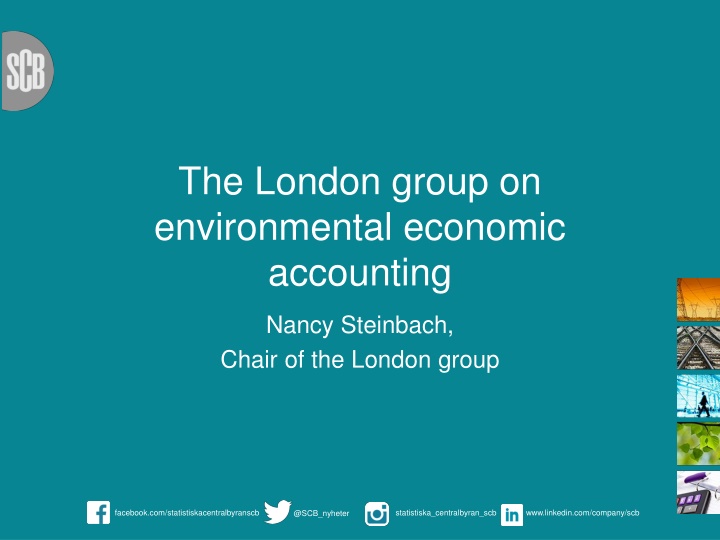
System of Environmental-Economic Accounts and Its Components
Learn about the System of Environmental and Economic Accounts, its purpose, and the important environmental and economic components it covers. Discover the organizations involved, the current plan, and key areas related to energy statistics. Dive into how this system showcases the interaction between the national economy and the environment, facilitating integrated analysis for economic models.
Download Presentation

Please find below an Image/Link to download the presentation.
The content on the website is provided AS IS for your information and personal use only. It may not be sold, licensed, or shared on other websites without obtaining consent from the author. If you encounter any issues during the download, it is possible that the publisher has removed the file from their server.
You are allowed to download the files provided on this website for personal or commercial use, subject to the condition that they are used lawfully. All files are the property of their respective owners.
The content on the website is provided AS IS for your information and personal use only. It may not be sold, licensed, or shared on other websites without obtaining consent from the author.
E N D
Presentation Transcript
The London group on environmental economic accounting Nancy Steinbach, Chair of the London group facebook.com/statistiskacentralbyranscb statistiska_centralbyran_scb www.linkedin.com/company/scb @SCB_nyheter
City group for the System of Environmental and Economic Accounts (SEEA) Created in 1993 to collaborate on development An informal group of experts primarily from national statistical agencies but also international organizations. Participation by representatives is voluntary To work on the further improvement of methodology, implementation and application of environmental economic accounts
What is the system of environmental and economic accounts about? Showing the resource use and environmental pressure by industry according to NACE/ISIC. Coupling this environmentally related information with the Economic National Accounts to be able to say how the national economy (production and consumption) and the environment interact. Allowing for integrated analysis in economic models and for making connections to the rich economic and social statistics.
Some important environmental and economic components described by the System of Environmental-Economic Accounts Trade
The organisation of it UN Statistical Commission (UNSC) UN Committee of Experts on Environmental Accounts (UNCEEA) Technical Committee on SEEA CF Technical Committee on SEEA EEA The London group bureau The London group
Current plan A three year workplan was developed setting out the process Work actively with the two research agendas: one for SEEA CF and one for SEEA experimental ecosystem accounting Sharing expertise and experience in policy use and implementation of methodology 23rd meeting to be held in Costa Rica autumn 2017
Important area 1 related to energy statistics: Air emissions Greenhouse gas emissions by NACE and pollutant, EU-28, 2014 (thousand tonnes of CO2 equivalents
Important area related to energy statistics: Energy accounts Energy supply by industries (NACE) and households, combined country summary 2013 Agriculture, forestry and fishing 3% Total activities by households 15% Construction 1% Water supply; sewerage, waste management and remediation activities 0% Mining and quarrying 16% Electricity, gas, steam and air conditioning supply 27% Manufacturing 38% Data source: Eurostat, extraction date August 2016
An example of compiling annual air emission accounts - Sweden
Challenges to go quarterly Challenges: To capture all emissions Finding relevant information for the most reecent quarter Solution: Use monthly and quarterly statistics as far as possible Fill gaps with modelling and forecasting of annnual data
Quarterly air emissions Stationary combustion Mobile combustion Other emissions missing short period data sources! Mining, quarrying, manufacturing, electricity, gas and heat production : Quarterly fuel statistics Calibrated for complicated industries 2008-2013: Annual data/4 2014-2015 as trends in annual data: Montligh fuel, gas and warehouse statistics CH4 from waste disposal: Decrease rate 8% per year Industry allocation and emission factors as the annual calculations Other industries: Annual energy balances Monthly fuel, gas and warehouse statistics Industry processes and product use: Modell according to industry prodcution index per industry and quarter Diffuse emissions, agriculture, other emissions from waste management : Same values as for 2013 Emissions factors the same as annual calculations
Concerning energy accounts A legal obligation in Europe to report physical flow energy accounts supply and use Following national accounts definitions but with some adjustments Important to establish cooperation between the environmental accountants and energy statistics! Energy balance approach vs. UNFCCC thinking
Conclusions The London group is active and an open community for cooperation! Energy statistics and energy balances important data source for the air emission accounts and the physical energy accounts! Encourage cooperation for improved statistics and enhanced knowledge about the areas in question!
